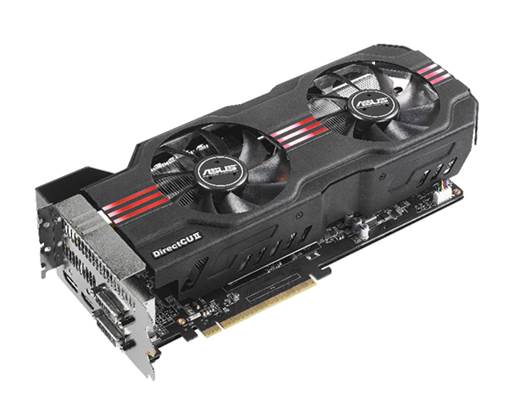Two overclocked flagships go head to
head one last time
Over the past year, the GeForce GTX 680 and
the Radeon HD 7970 have served as the respective flagship GPUs for each of
their camps, and even though both cards seem a bit tike well-aged cheese by
now, they are still as fast as it gets in the single-GPU world, and will be
until their successors are unleashed. However, the unleashing may not happen
for a few months, and when it does, the new monster cards will be oh-so-pricey,
making these "last-gen" super-cards an excellent value. There have
also been quite a few driver updates since these cards were released, so we've
decided to pit two of the overclocked versions against one another in a battle
royale to settle this feud once and for all. Fighters, touch circuit boards and
come out of your PCI Express corners. It's time to get it on!
ASUS Geforce GTX 680 Directcu II Top
There are many flavors of GeForce GTX 680
out in the wild, from cards that have only modified the reference design with
pretty stickers to this heavily mutated bad boy from Asus. For those not
familiar with Asus nomenclature, this is the DirectCU II version of the GTX
680, meaning it features a heat pipe and fan-based cooler approximately the
size of mainland China. The cooler utilizes five copper heat pipes that make
direct contact with the GK104 Kepler GPU. The heat pipes fan out above the GPU
and to the edge of the card, sending the heat they've collected into two
separate heatsinks. Twin 100mm fans then blow into the heatsinks, exhausting
the warm air outside of the chassis. It's a superb design that we've lavished
praise on before because, even though it’s a bit large, it works extremely
well, and keeps the GPU just the way we like it cool and quiet. Asus claims a
noise reduction of UdB compared to the reference design prepared by Nvidia, and
we believe it even though we don’t specifically measure sound output. All this
cooling takes up a bit of space, though, and this card's triple-slot design
makes it the biggest GTX 680 ever to grace our test bench.

This
is the directcu II version of the GTX 680, meaning it features a heat pipe and
fan-based cooler approximately the size of mainland China.
Some of you might be asking, "But
wait, the GTX 680 already runs cool and quiet, so why is a cooler the size of
Gordon Mah Ung's anger-management therapy bill required in this
situation?" That's a good question, and the answer is in the second part
of our nomenclature lesson, which is the word TOP in the card's name, which
means it's over-clocked like a son-of-a-gun to the tune of 131MHz over stock
speeds at 1,137MHz. Its Boost Clock gets a gentle massage all the way up to
1,201MHz, as well. Memory is not overclocked, however. The card also comes with
Asus's GPU Tweak software that lets you not only monitor the card's temps, fan
speeds, voltages, and clock speeds, but also manually adjust all those values.
The card even supports an Asus-exclusive feature called VGA Hotwire that’s also
supported on several Asus motherboards (it has to be supported on both to
work). It lets you adjust the GPU's voltage once you've soldered several wires
that run from the motherboard to the video card's PCB. This allows for control
at a hardware level instead of using software, and is designed for extreme
overclocking enthusiasts, to put it mildly.

The
Asus GeForce GTX 680 DirectCU II TOP's name is almost as long as the 11-inch
card.
During testing, the overclocked Asus GTX
680 held a crystal-clear advantage over the overclocked Radeon HD 7970, which
might not be too surprising to you, but it was a surprise to us. When we tested
these same video cards (not these exact cards, but reference models at stock
clock speeds] just a few months ago using the latest beta drivers from each
manufacturer, it was a photo finish in practically every test, with AMD holding
a very slight advantage. This was a distinct coup for AMD, which had always
trailed Nvidia in these comparisons previously, and it all came down to
drivers, essentially. AMD had released its beta 12.11 drivers, claiming they
made a significant impact on performance, and they were right.
Perhaps it's fitting then, that this time
around it is most likely drivers that have put Nvidia ahead, as we tested this
card with the 310.70 version of the drivers, which were released about a month
after the 12.10 drivers we used to test the Radeon card. As we were going to
press, Nvidia released another version of its drivers numbered 310.90, claiming
even further improvements, but they arrived too close to deadline for us to
test them. However, the advantage Nvidia holds is clear, both in the benchmark
numbers and frequency of driver updates. Drivers are clearly a weak point for
AMD, and in this face-off it most likely made all the difference.

We should point out that the Asus card was
totally silent at all times during testing, a remarkable feat given its
overclocked status and its superb performance. It beat the AMD card in every
test except Metro, where it lost by one frame per second, so not much of a
loss, really. The numbers don't lie, though, and as we close the book on this
era of GPUs, the crown goes to the green camp, and we'll award a crown to Asus
too, for making the fastest, and most silent, GTX 680 we've ever tested.